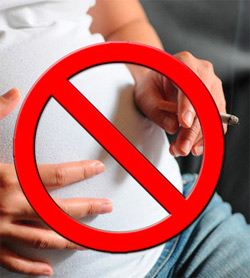|
|
|
|
In utero exposures to maternal smoking place men's reproductive health at risk
- Reported, March 4, 2004
 According to a study from
Denmark, "between 1996 and 1999, the authors invited all young men from five
European countries who were undergoing compulsory medical examination for
possible military service to participate in a study on male reproductive
health. The participation rate was 19% in two cities in Denmark (n=889), 17%
in Oslo, Norway (n=221), 13% in Turku, Finland (n=313), 14% in Kaunas,
Lithuania (n=157), and 19% in Tartu, Estonia (n=190). Each man provided a
semen sample, was examined by a physician, and, in collaboration with his
mother, completed a questionnaire about general and reproductive health,
current smoking habits, and exposure to smoking in utero." According to a study from
Denmark, "between 1996 and 1999, the authors invited all young men from five
European countries who were undergoing compulsory medical examination for
possible military service to participate in a study on male reproductive
health. The participation rate was 19% in two cities in Denmark (n=889), 17%
in Oslo, Norway (n=221), 13% in Turku, Finland (n=313), 14% in Kaunas,
Lithuania (n=157), and 19% in Tartu, Estonia (n=190). Each man provided a
semen sample, was examined by a physician, and, in collaboration with his
mother, completed a questionnaire about general and reproductive health,
current smoking habits, and exposure to smoking in utero."
"After adjustment for confounding factors, men exposed to smoking in utero
had a reduction in sperm concentration of 20.1% (95% confidence interval
(CI): 6.8, 33.5) and a reduction in total sperm count of 24.5% (95% CI: 9.5,
39.5) in comparison with unexposed men," reported T.K. Jensen and
colleagues, University Copenhagen, Rigshospital.
"Percentages of motile and morphologically normal sperm cells were 1.85 (95%
CI: 0.46, 3.23) and 0.64 (95% CI: -0.02, 1.30) percentage points lower,
respectively, among men exposed in utero, and exposed men had a 1.15-ml (95%
CI: 0.66, 1.64) smaller testis size. The associations were present when data
from the study centers were analyzed separately (though not in Lithuania,
where only 1% of mothers smoked during pregnancy), although the strength of
the association varied."
"Maternal smoking may have long-term implications for the reproductive
health of the offspring. This is another good reason to advise pregnant
women to avoid smoking," researchers concluded.
Jensen and colleagues published the results of their research in American
Journal of Epidemiology (Association of in utero exposure to maternal
smoking with reduced semen quality and testis size in adulthood: A
cross-sectional study of 1,770 young men from the general population in five
European countries. Am J Epidemiol, 2004;159(1):49-58).
For additional information, contact T.K. Jensen, University Copenhagen,
Rigshosp, Department Growth & Reproductive, GR 5064, Blegdamsvej 9, DK-2100
Copenhagen, Denmark.
The publisher of the American Journal of Epidemiology can be contacted at:
Oxford University Press Inc., Journals Department, 2001 Evans Rd., Cary, NC
27513, USA.
|
|
|
|
|
|
|









